Effect of Phosphogypsum Based Filler on the Performance of Asphalt Mortar and Mixture
Abstract
1. Introduction
2. Materials and Methods
2.1. Raw Material
2.1.1. Phosphogypsum and Steel Slag Powder
2.1.2. Asphalt
2.1.3. Aggregate and Filler
2.2. Experimental Methods
2.2.1. Preparation of PF
2.2.2. Preparation of Asphalt Mortar
2.2.3. Experiments Using Asphalt Mortar
Determination of P-AM Composition
Determination of PL-AM
Rheological Performance
2.2.4. Pavement Performance of PF Based Asphalt Mixture
High-Temperature Performance
Low-Temperature Flexural Performance
Moisture Stability
3. Results and Discussions
3.1. Determination of PF Composition
3.1.1. Physical Properties of P-AM
3.1.2. Adhesion Characterization
3.2. Effect of PF Content on PL-AM’s Mechanical Properties
3.2.1. Penetration
3.2.2. Softening Point
3.2.3. Ductility
3.2.4. PI and T800
3.3. Determination of PF Content
3.4. Rheological Properties
3.5. Pavement Performance
3.5.1. Volumetric Performance
3.5.2. High-Temperature Performance
3.5.3. Low-Temperature Flexural Performance
3.5.4. Moisture Stability
4. Conclusions
- (1)
- PF enhanced asphalt mortar’s softening point and ductility, while penetration was reduced. Steel slag powder clearly improved the adhesion between P-AM and aggregate when its content was over 20%. The highest softening point and lowest penetration occurred when content of steel slag powder was 23%, according to the fitting curve.
- (2)
- PL-AM presented the lowest penetration when 75% limestone filler was replaced by PF. Similarly, the highest softening point, penetration index and equivalent softening point were also found when PF content was 75%. The filler-asphalt ratio was positively correlated to softening point, penetration index and equivalent softening point, while it negatively affected penetration and ductility. The overall desirability achieved the maximum value when PF content was 75% based on PL-AM mechanical performance. Consequently, the optimum PF content was determined as 75% in replacing limestone filler.
- (3)
- The complex shear modulus of PL-AM was improved by PF. PL-AM showed a higher phase angle from 30 to 60 °C, while the contrary result was found from 60 to 80 °C. PF showed no significant effect on volumetric and low-temperature performance. High-temperature and moisture stability performance were improved by PF. Thus, using phosphogypsum based filler containing steel slag powder to partly replace limestone filler improved the asphalt mixture’s pavement performance.
Author Contributions
Funding
Institutional Review Board Statement
Informed Consent Statement
Data Availability Statement
Conflicts of Interest
References
- Li, P.; Ding, Z.; Rao, W. Evaluation of deformation properties of asphalt mixture using aggregate slip test. Int. J. Pavement Eng. 2016, 17, 542–549. [Google Scholar] [CrossRef]
- Zhang, X.; Zhang, B.; Chen, H.; Kuang, D. Feasibility evaluation of preparing asphalt mixture with low-grade aggregate, rubber asphalt and desulphurization gypsum residues. Materials 2018, 11, 1481. [Google Scholar] [CrossRef]
- Dai, Q.; Ma, L.; Xie, L.; Yan, B.; Zheng, D.; Yang, J. Analyses on the application of components in the phosphogypsum decomposition residue: Based on the study of migration and conversion rules of elements in the purification procedure of CaO. Environ. Prog. Sustain. Energy 2018, 37, 1020–1030. [Google Scholar] [CrossRef]
- Smaoui-Jardak, M.; Kriaa, W.; Maalej, M.; Zouari, M.; Kamoun, L.; Trabelsi, W.; Ben Abdallah, F.; Elloumi, N. Effect of the phosphogypsum amendment of saline and agricultural soils on growth, productivity and antioxidant enzyme activities of tomato (Solanum lycopersicum L.). Ecotoxicology 2017, 26, 1089–1104. [Google Scholar] [CrossRef]
- Moalla, R.; Gargouri, M.; Khmiri, F.; Kamoun, L.; Zairi, M. Phosphogypsum purification for plaster production: A process optimization using full factorial design. Environ. Eng. Res. 2018, 23, 36–45. [Google Scholar] [CrossRef]
- Islam, G.S.; Chowdhury, F.H.; Raihan, M.T.; Amit, S.S.; Islam, M.R. Effect of phosphogypsum on the properties of Portland cement. Procedia Eng. 2017, 171, 744–751. [Google Scholar] [CrossRef]
- Rashad, A.M. Phosphogypsum as a construction material. J. Clean. Prod. 2017, 166, 732–743. [Google Scholar] [CrossRef]
- Wang, C.-Q.; Xiong, D.-M.; Chen, Y.; Wu, K.; Tu, M.-J.; Wang, P.-X.; Zhang, Z.-J.; Zhou, L. Characteristic pollutant purification analysis of modified phosphogypsum comprehensive utilization. Environ. Sci. Pollut. Res. 2022, 29, 67456–67465. [Google Scholar] [CrossRef]
- Ou, L.; Zhu, H.; Xu, Y.; Chen, R.; Yang, X. Gray correlation entropy analysis of zero shear viscosity and high-temperature rheological parameters of phosphogypsum-modified asphalt. Case Stud. Constr. Mater. 2022, 17, e01448. [Google Scholar] [CrossRef]
- Gregory, C.; Saylak, D.; Ledbetter, W.B. The use of by-product phosphogypsum for road bases and subbases. Transp. Res. Rec. 1984, 998, 47–52. [Google Scholar]
- Li, J.; Zhang, Y.; Mao, L.; Zi, J.; Hu, T. Laboratory research on the application of phosphogypsum as an anti-cracking agent in a cement-treated base. In CICTP 2014: Safe, Smart, and Sustainable Multimodal Transportation Systems; American Society of Civil Engineers: Reston, VA, USA, 2014; pp. 990–1002. [Google Scholar]
- Cuadri, A.; Navarro, F.; García-Morales, M.; Bolívar, J. Valorization of phosphogypsum waste as asphaltic bitumen modifier. J. Hazard. Mater. 2014, 279, 11–16. [Google Scholar] [CrossRef]
- Shen, W.; Zhou, M.; Ma, W.; Hu, J.; Cai, Z. Investigation on the application of steel slag–fly ash–phosphogypsum solidified material as road base material. J. Hazard. Mater. 2009, 164, 99–104. [Google Scholar] [CrossRef]
- Dutta, R.K.; Kumar, V. Suitability of flyash-lime-phosphogypsum composite in road pavements. Period. Polytech. Civ. Eng. 2016, 60, 455–469. [Google Scholar] [CrossRef]
- Amrani, M.; El Haloui, Y.; Hajikarimi, P.; Sehaqui, H.; Hakkou, R.; Barbachi, M.; Taha, Y. Feasibility of using phosphate wastes for enhancing high-temperature rheological characteristics of asphalt binder. J. Mater. Cycles Waste Manag. 2020, 22, 1407–1417. [Google Scholar] [CrossRef]
- Cuadri, A.; Pérez-Moreno, S.; Altamar, C.; Navarro, F.; Bolívar, J. Phosphogypsum as additive for foamed bitumen manufacturing used in asphalt paving. J. Clean. Prod. 2021, 283, 124661. [Google Scholar] [CrossRef]
- Meskini, S.; Samdi, A.; Ejjaouani, H.; Remmal, T. Valorization of phosphogypsum as a road material: Stabilizing effect of fly ash and lime additives on strength and durability. J. Clean. Prod. 2021, 323, 129161. [Google Scholar] [CrossRef]
- Zhao, M.; Wu, S.; Chen, Z.; Li, C. Production and application of steel slag coarse aggregate in asphalt mixture. Emerg. Mater. Res. 2017, 6, 219–222. [Google Scholar] [CrossRef]
- Chen, J.-S.; Wei, S.-H. Engineering properties and performance of asphalt mixtures incorporating steel slag. Constr. Build. Mater. 2016, 128, 148–153. [Google Scholar] [CrossRef]
- Guo, Y.; Wu, H.; Shen, A.; Yang, X.; Cui, T. Study of the long-term water stability of asphalt mixtures containing steel slag aggregate. J. Adhes. Sci. Technol. 2020, 34, 877–902. [Google Scholar] [CrossRef]
- Wan, J.; Wu, S.; Xiao, Y.; Fang, M.; Song, W.; Pan, P.; Zhang, D. Enhanced ice and snow melting efficiency of steel slag based ultra-thin friction courses with steel fiber. J. Clean. Prod. 2019, 236, 117613. [Google Scholar] [CrossRef]
- Chen, Z.; Leng, Z.; Jiao, Y.; Xu, F.; Lin, J.; Wang, H.; Cai, J.; Zhu, L.; Zhang, Y.; Feng, N. Innovative use of industrially produced steel slag powders in asphalt mixture to replace mineral fillers. J. Clean. Prod. 2022, 344, 131124. [Google Scholar] [CrossRef]
- Ghosh, A.; Mal, P.; Majumdar, A.; Banerjee, D. Optimization of knitted fabric comfort and UV protection using desirability function. J. Eng. Fibers Fabr. 2016, 11, 155892501601100404. [Google Scholar] [CrossRef]
- Alam, M.S.; Ghosh, A.; Majumdar, A. Optimization of bending and shear rigidities of woven fabrics using desirability function. J. Text. Inst. 2020, 111, 1318–1323. [Google Scholar] [CrossRef]
- Wang, F.; Li, Y.; Yu, L.; Pang, W. Study on Influencing Factors of Asphalt-Aggregate Stripping Mechanism. Adv. Mater. Sci. Eng. 2021, 2021, 1–7. [Google Scholar] [CrossRef]
- Zeng, M.; Pan, H.; Zhao, Y.; Tian, W. Evaluation of asphalt binder containing castor oil-based bioasphalt using conventional tests. Constr. Build. Mater. 2016, 126, 537–543. [Google Scholar] [CrossRef]
- Anahas, A.M.P.; Muralitharan, G. Central composite design (CCD) optimization of phytohormones supplementation for enhanced cyanobacterial biodiesel production. Renew. Energy 2019, 130, 749–761. [Google Scholar] [CrossRef]
- Van Houtven, J.; Hooyberghs, J.; Laukens, K.; Valkenborg, D. CONSTANd: An efficient normalization method for relative quantification in small-and large-scale omics experiments in R BioConductor and Python. J. Proteome Res. 2021, 20, 2151–2156. [Google Scholar] [CrossRef]
- Jian, R.; Hu, X.; Han, T.; Wan, J.; Gan, W.; Chen, Z.; Zhang, Y.; Cao, C. Optimization of induction heating parameters for improving Self-healing performance of asphalt mixture through partial least square model. Constr. Build. Mater. 2023, 365, 130019. [Google Scholar] [CrossRef]
- Wang, B.; Hu, X.; Cao, C.; Wan, J.; Gan, W.; Chen, Z.; Cai, C. Development and characterization of permeative anti-rutting agent for asphalt mixture enhancement. Constr. Build. Mater. 2023, 364, 129937. [Google Scholar] [CrossRef]
- Tian, Y.; Sun, L.; Li, H.; Zhang, H.; Harvey, J.; Yang, B.; Zhu, Y.; Yu, B.; Fu, K. Laboratory investigation on effects of solid waste filler on mechanical properties of porous asphalt mixture. Constr. Build. Mater. 2021, 279, 122436. [Google Scholar] [CrossRef]
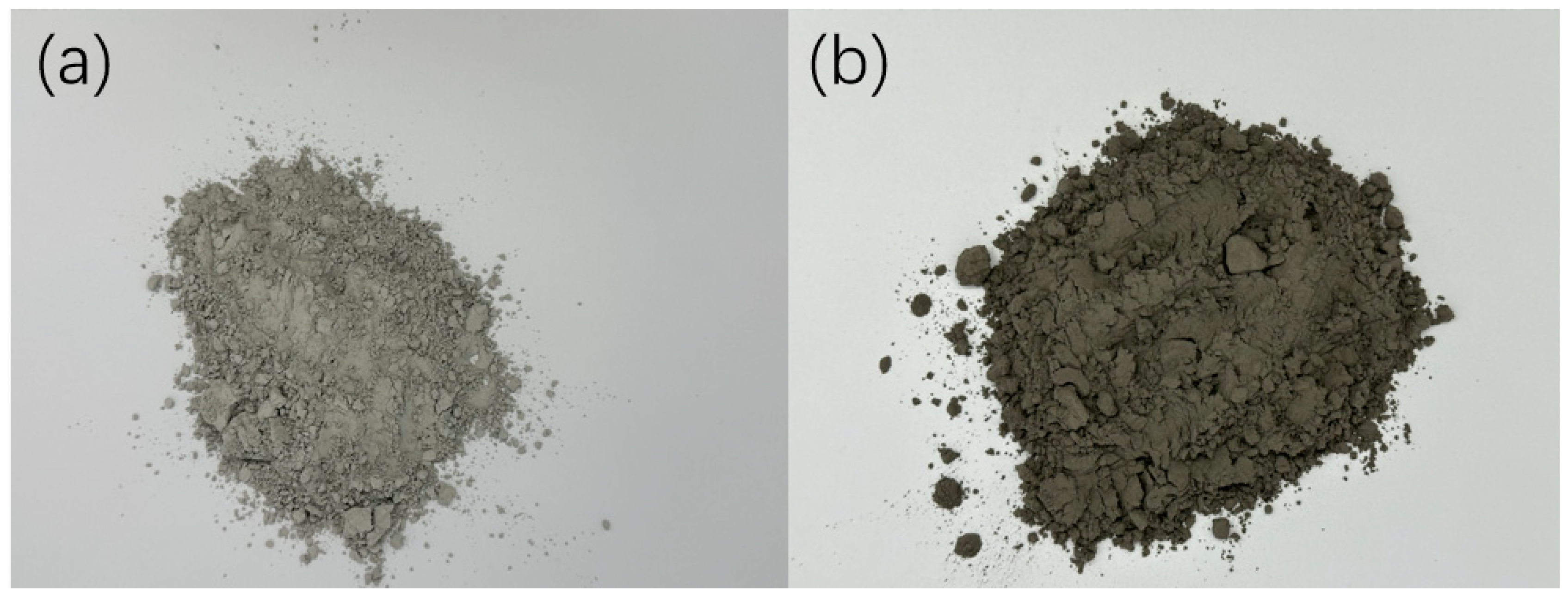
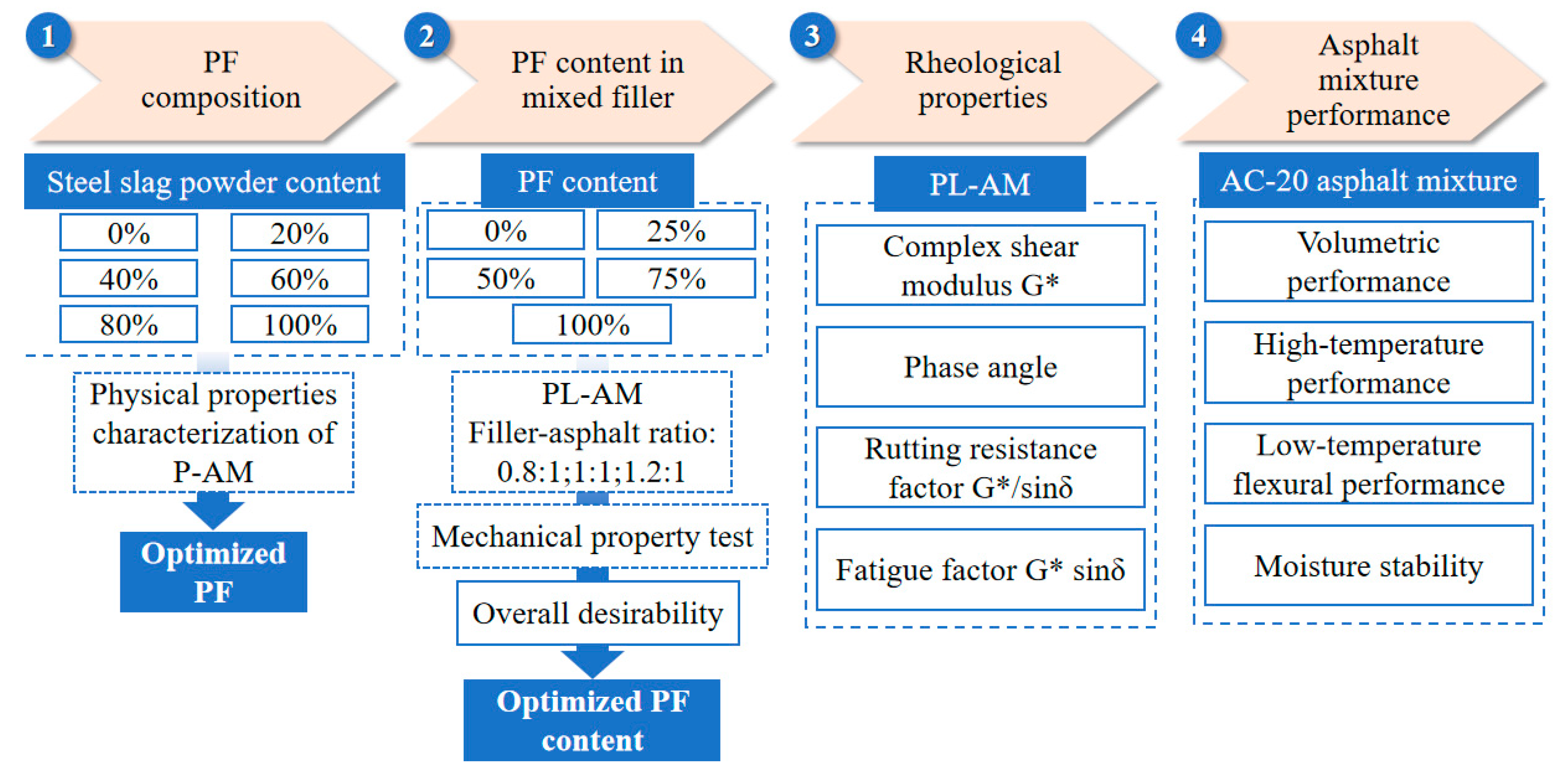
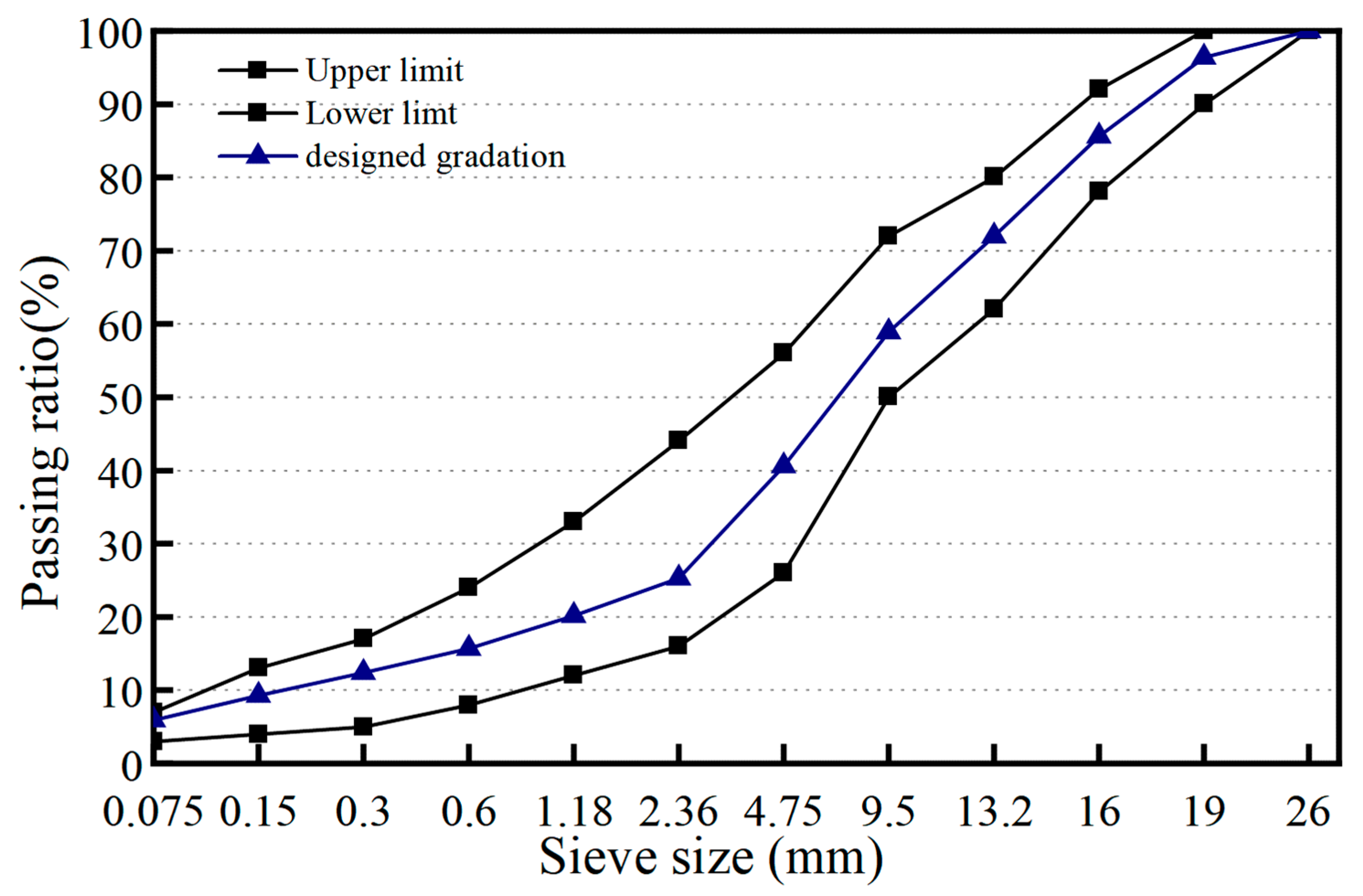
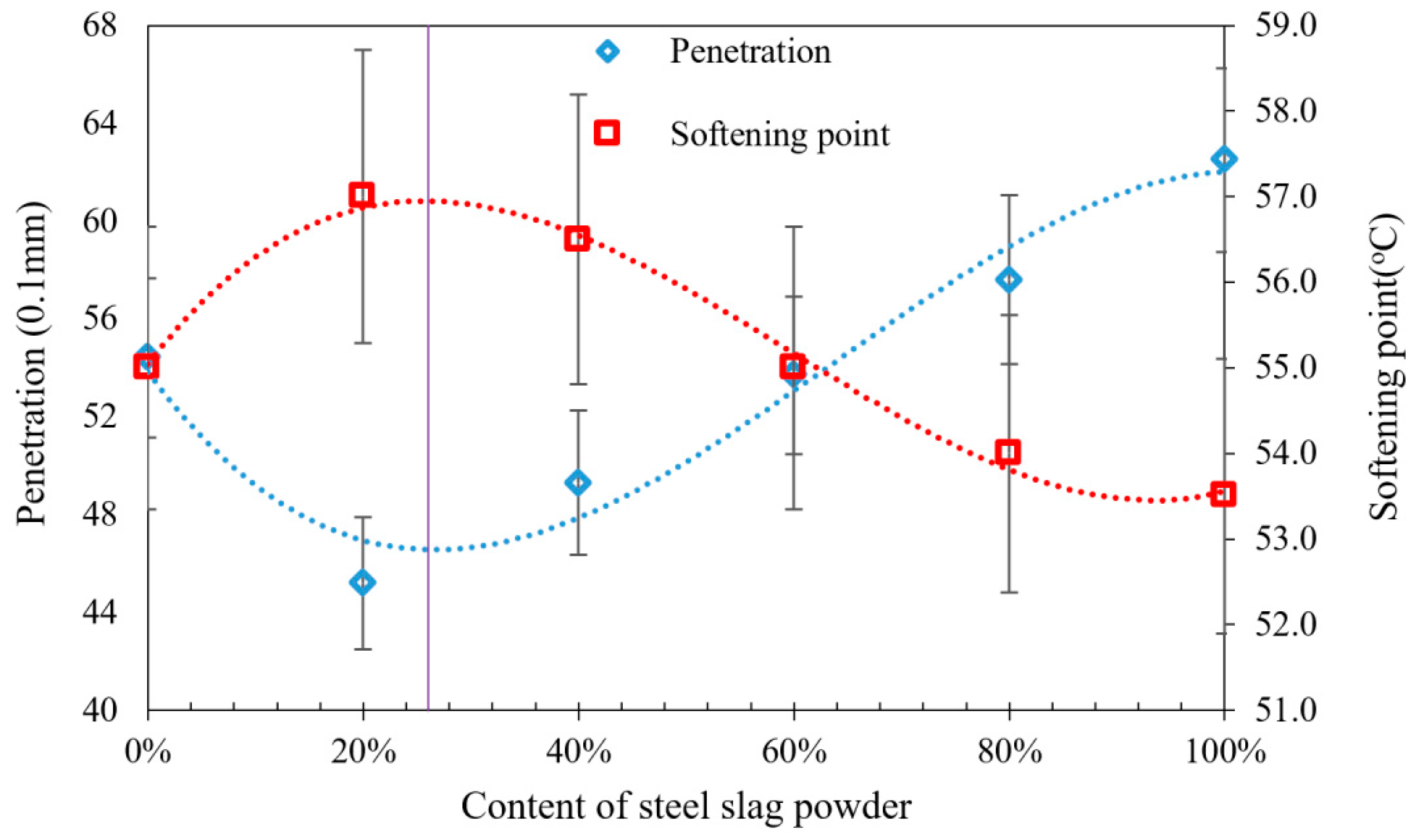
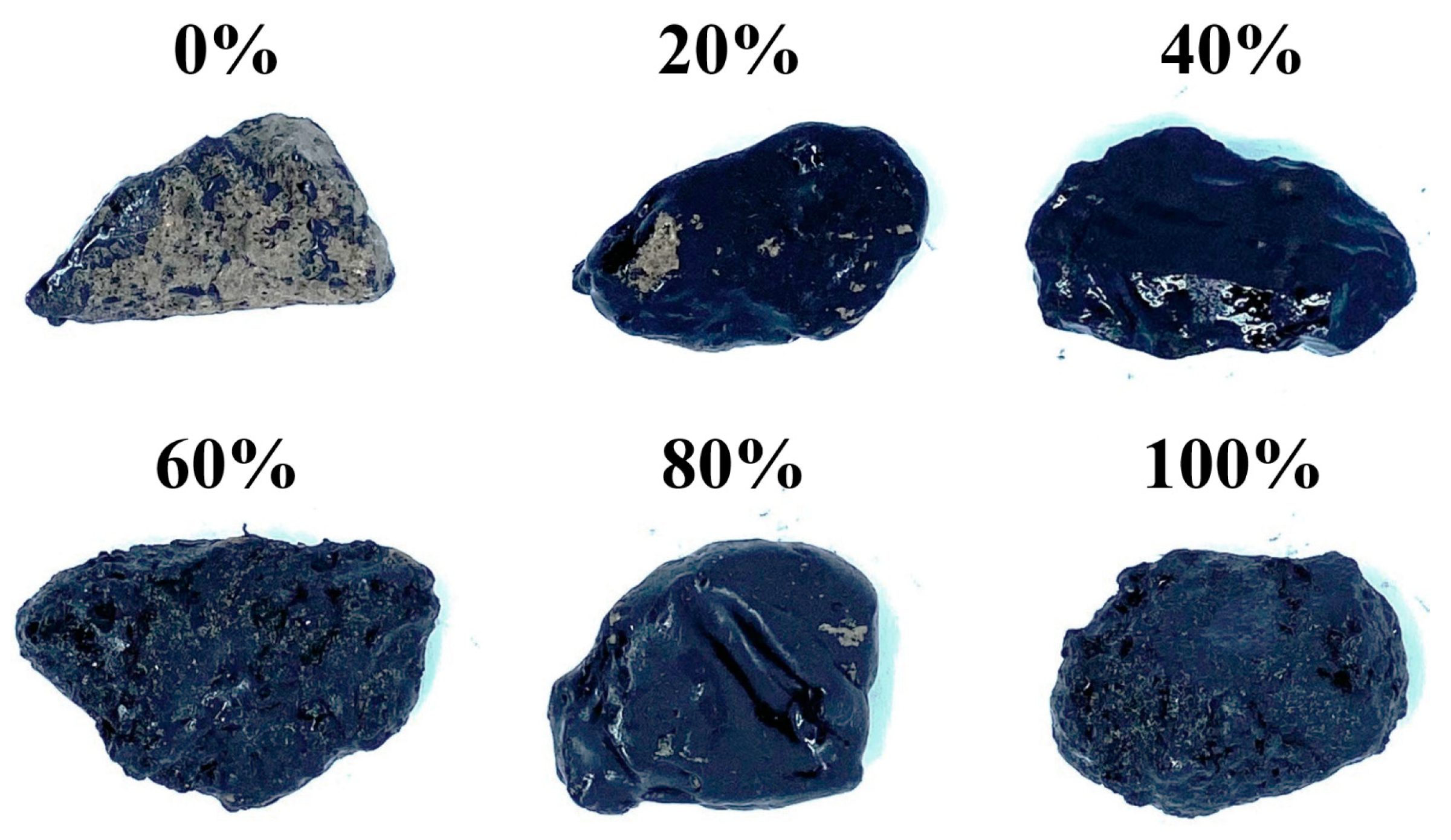
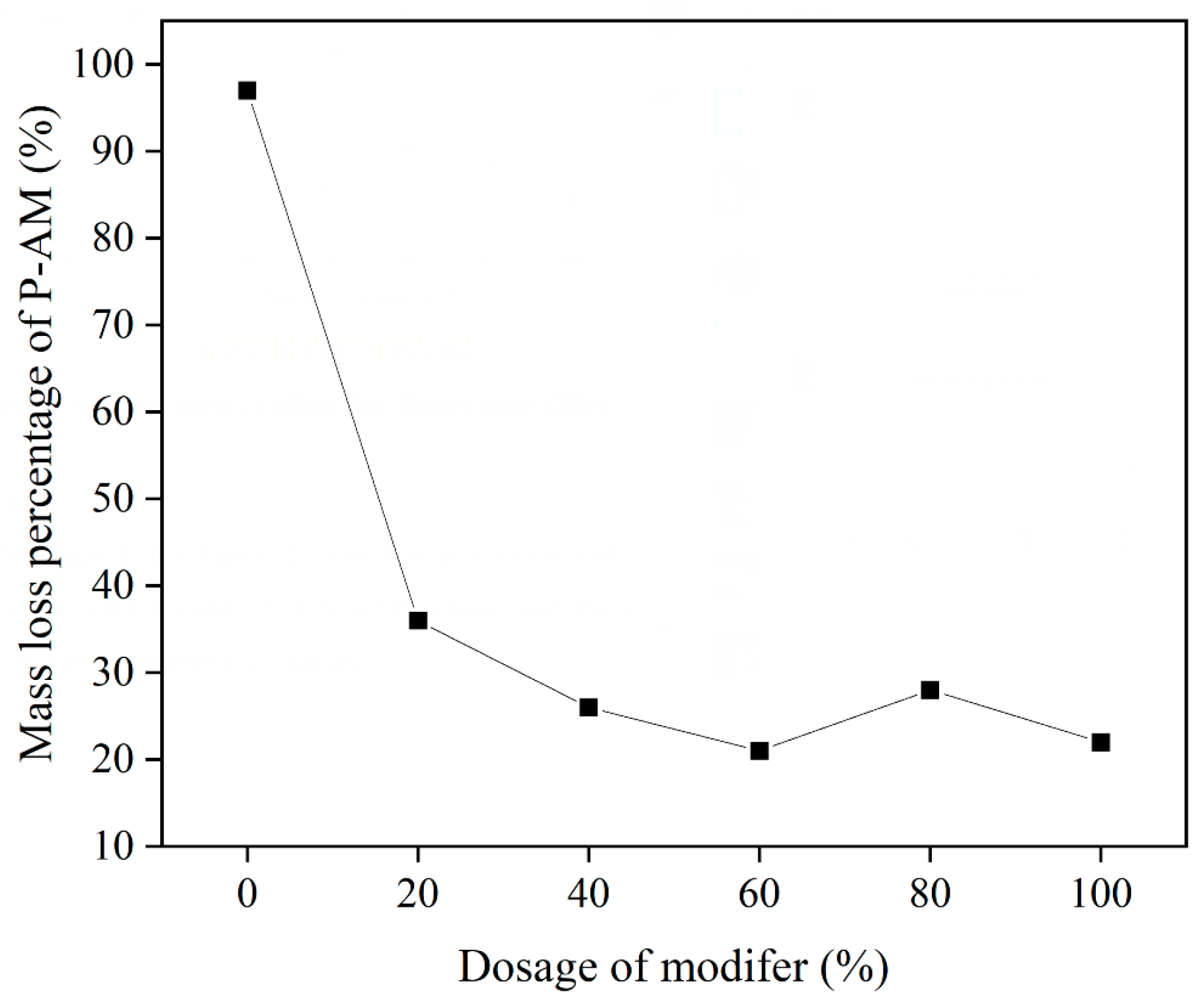
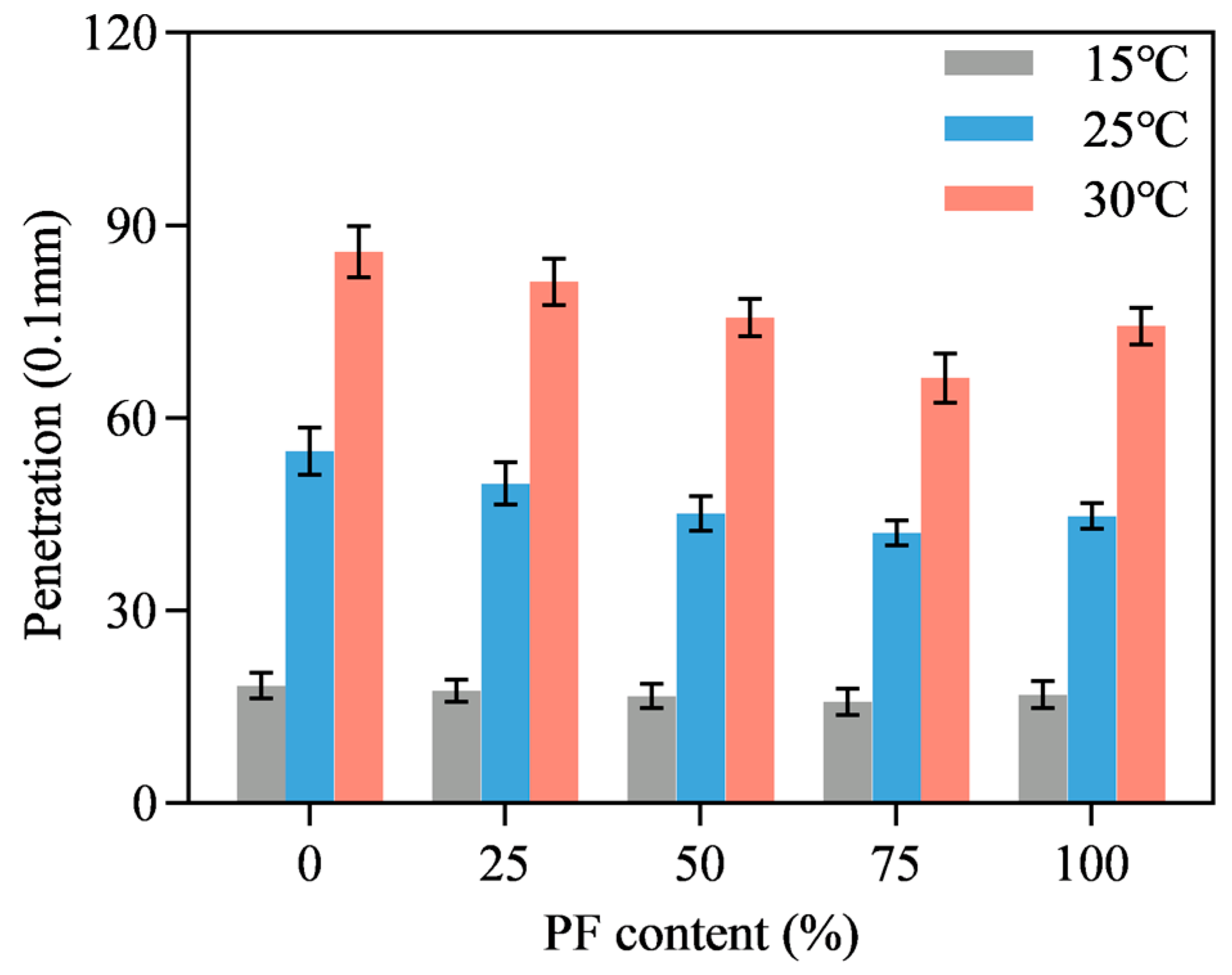
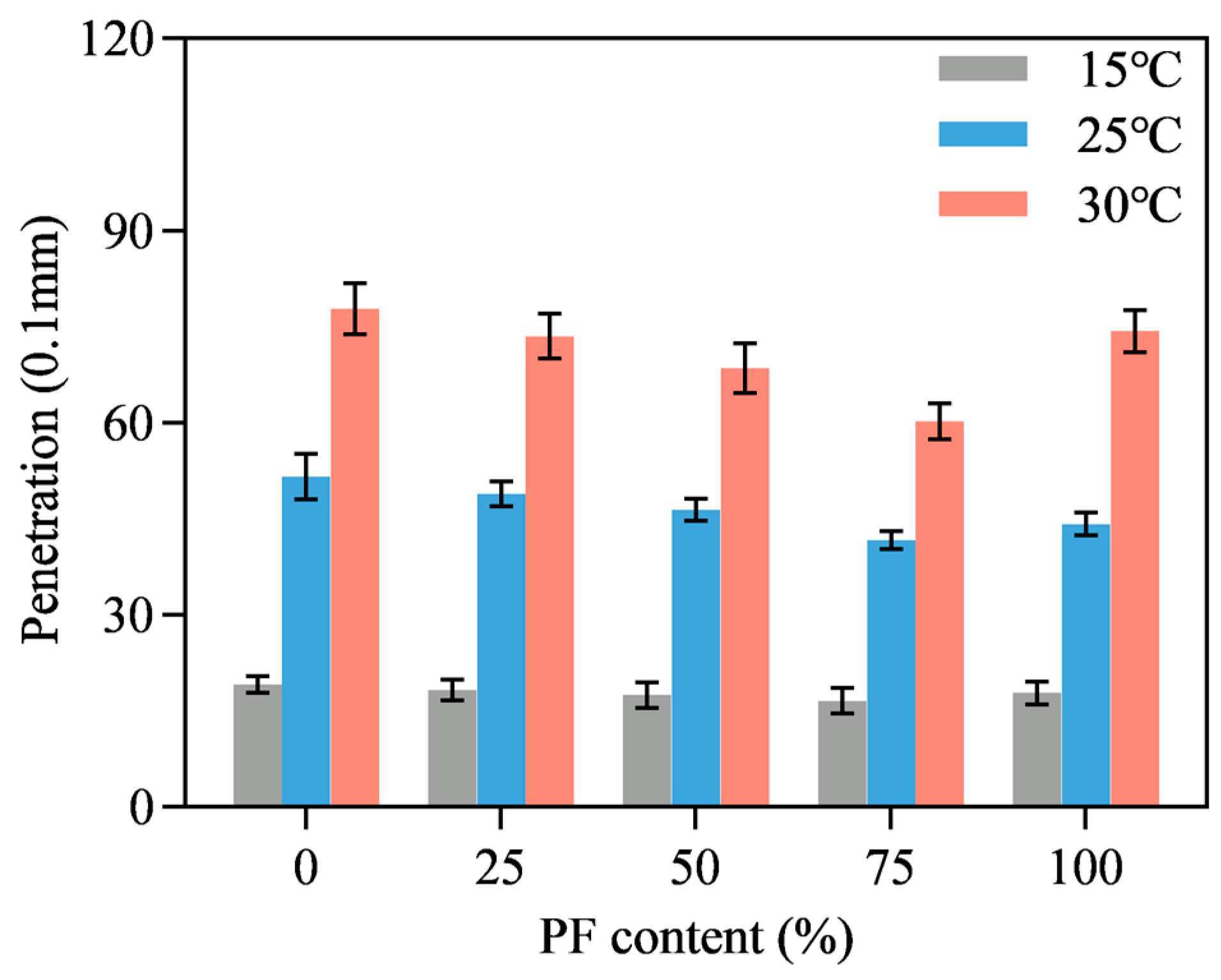
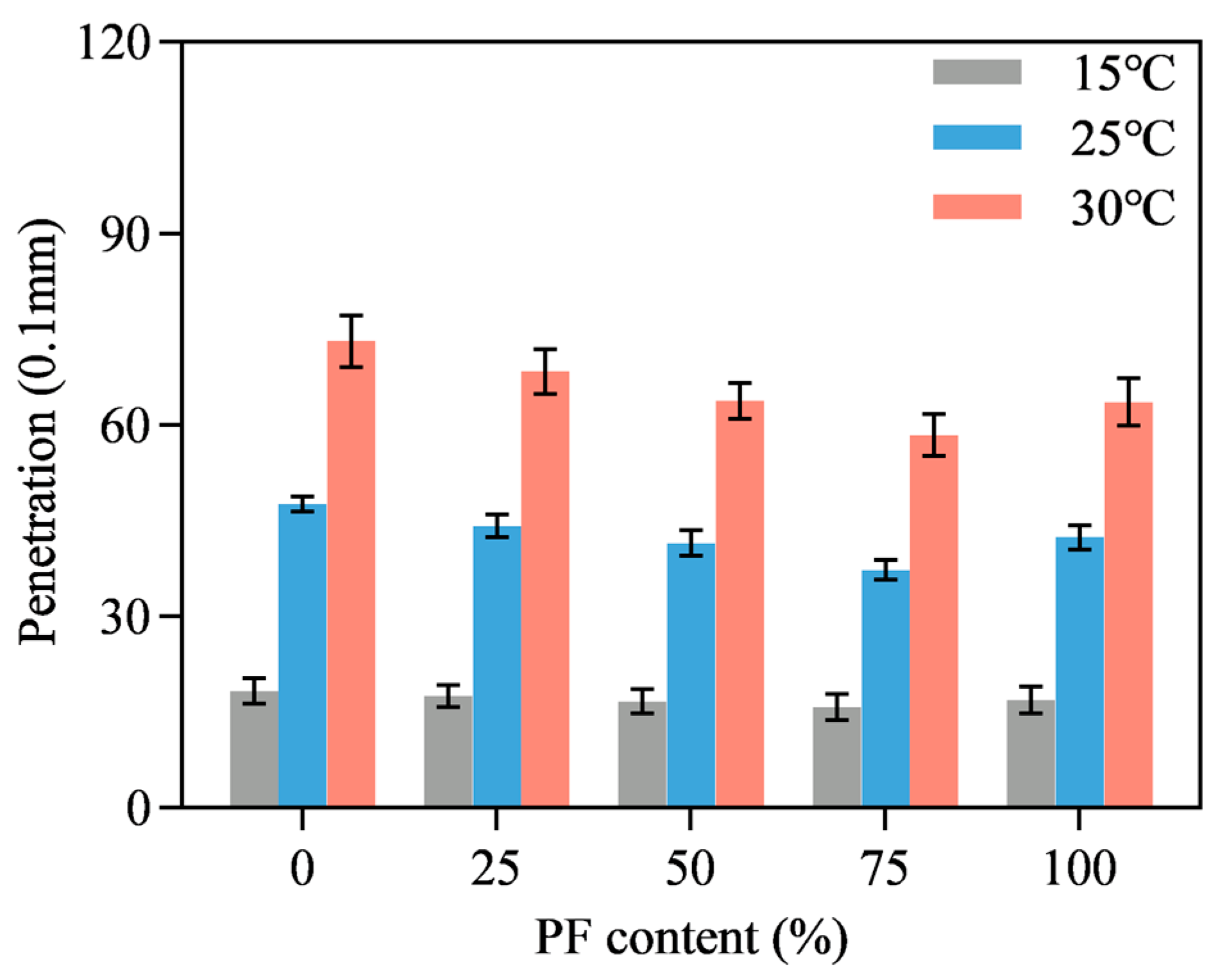


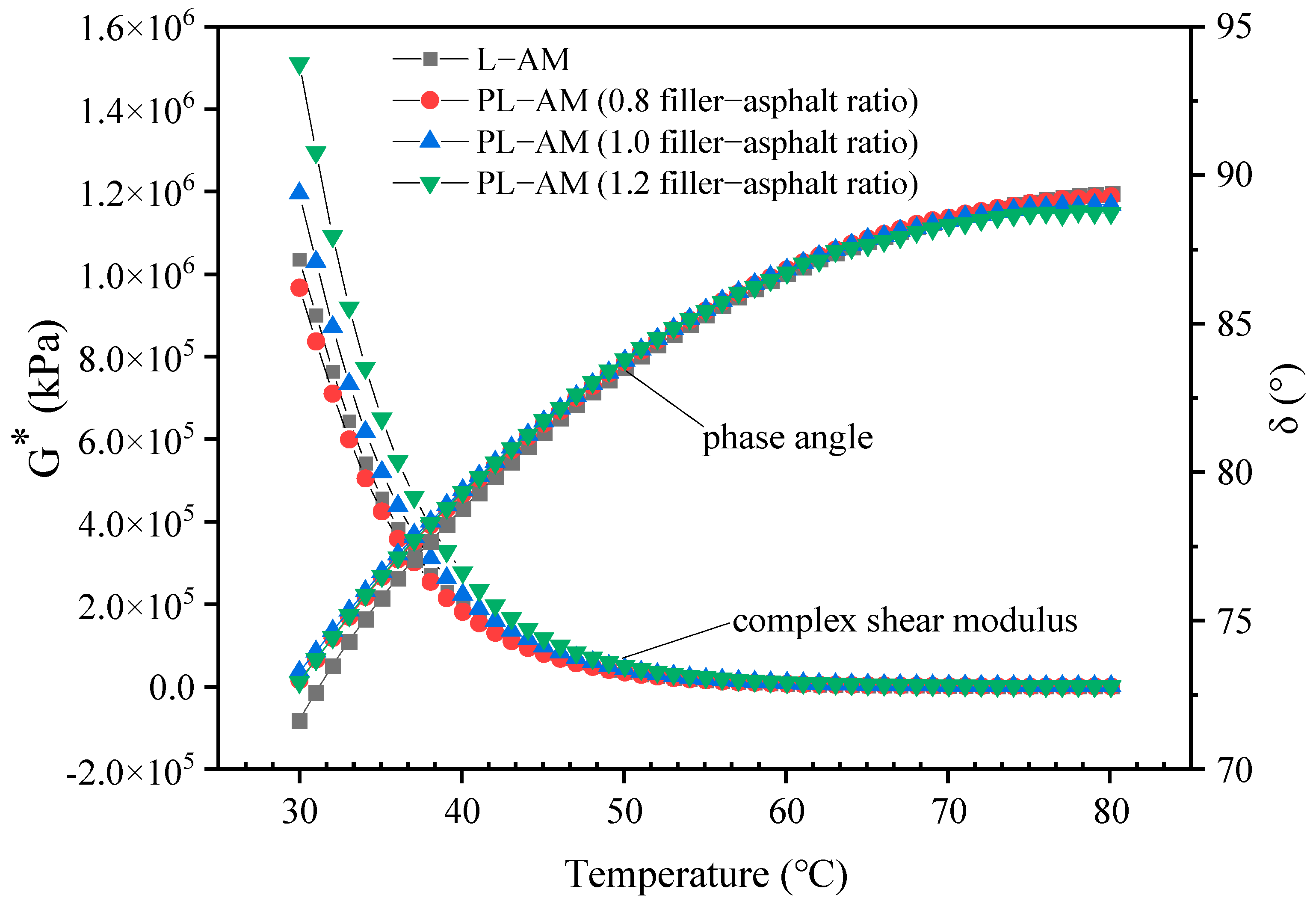
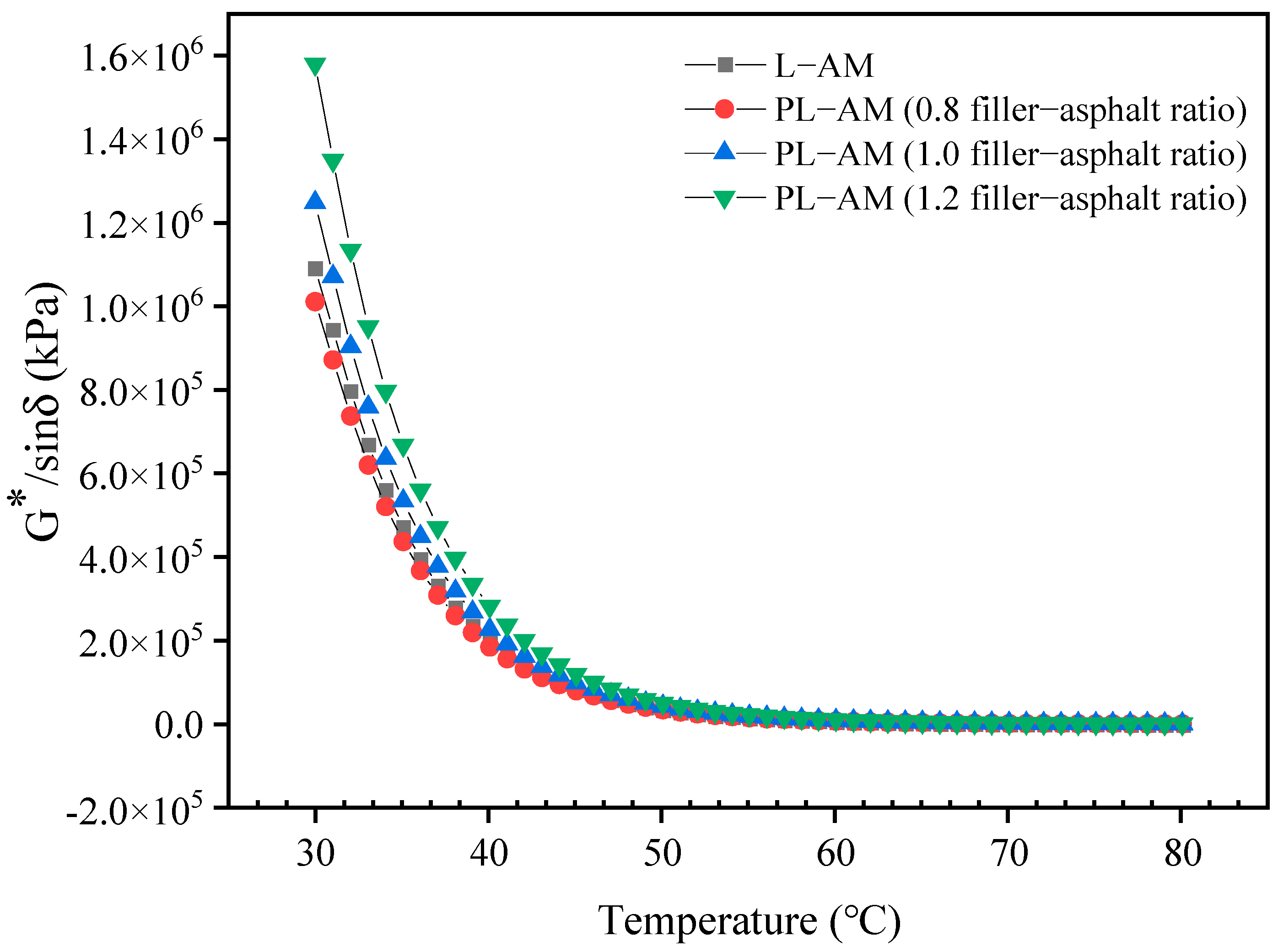
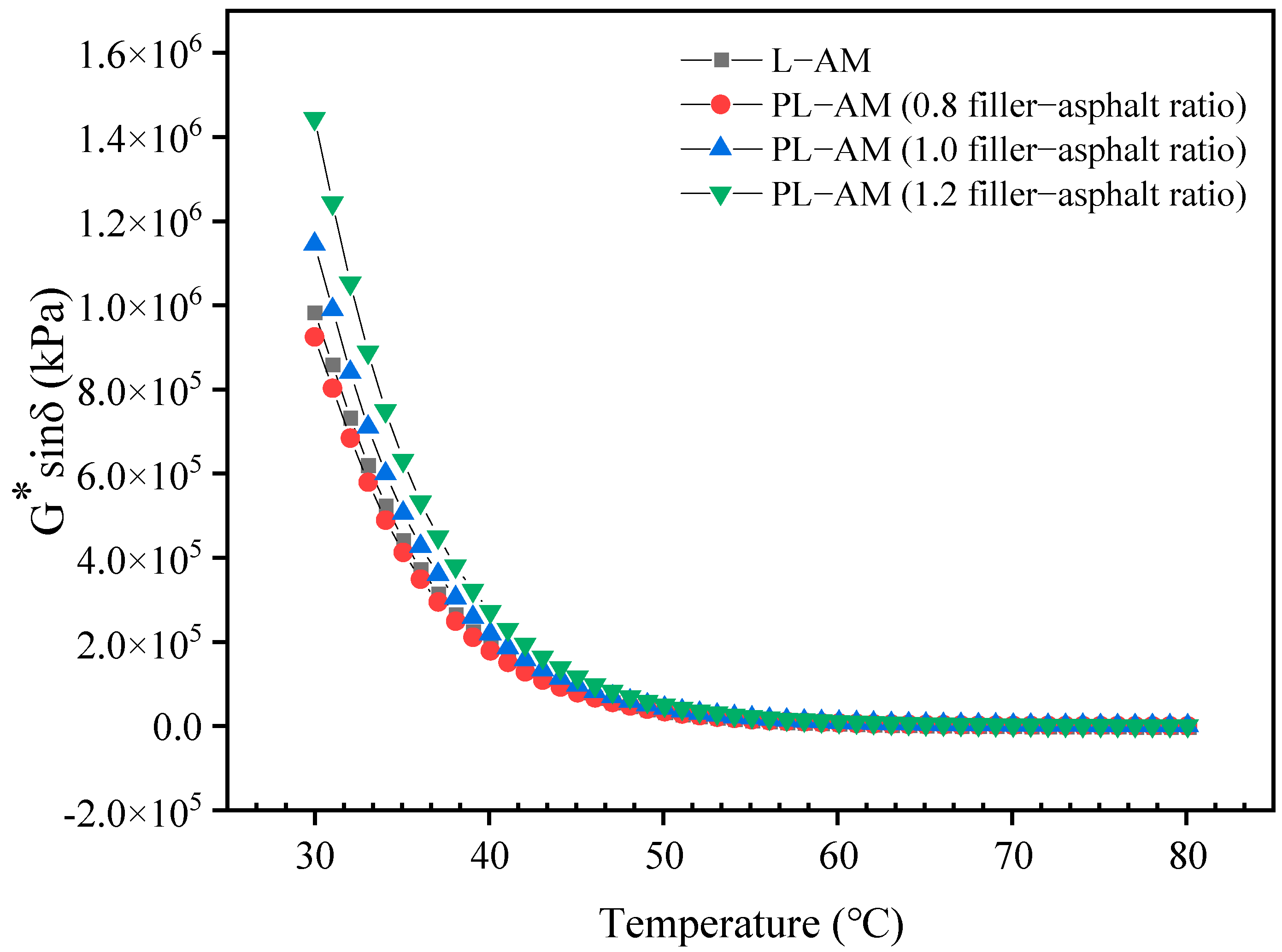
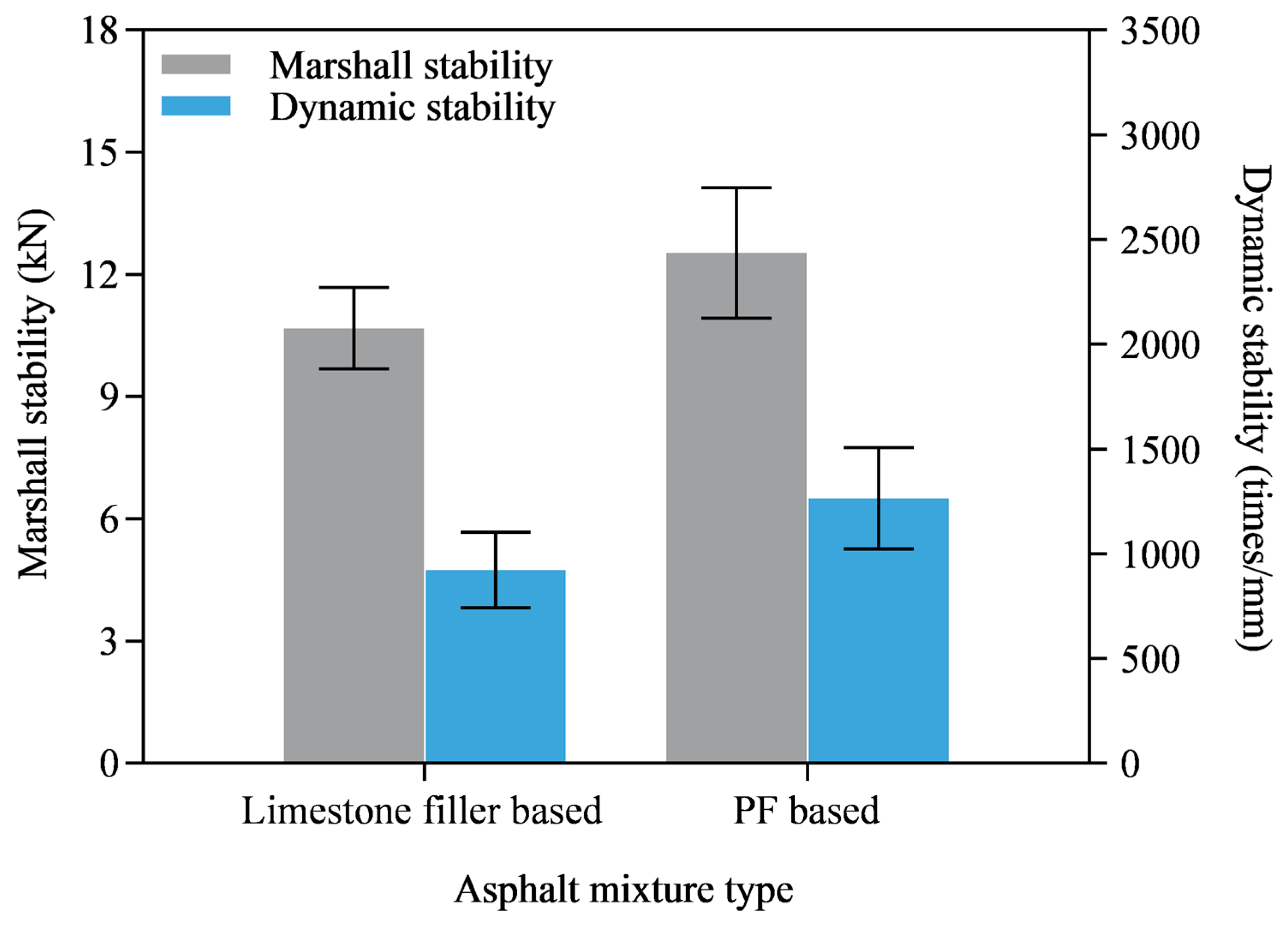
| Composition | SO3 | Al2O3 | SiO2 | CaO | P2O5 | Fe2O3 | MgO |
|---|---|---|---|---|---|---|---|
| Phosphogypsum | 44.5% | 0.9% | 9.5% | 31.1% | 2.5% | 0.7% | / |
| Steel slag powder | / | 22.2% | 43.9% | 17.8% | / | 2.9% | 5.7% |
| Technical Index | Test Results | Requirements |
|---|---|---|
| Penetration (25 °C, 0.1 mm) | 70.7 | 60–80 |
| Softening point (°C) | 49.0 | ≥46 |
| Ductility (15 °C, cm) | >100 | ≥100 |
| Viscosity (135 °C, Pa·s) | 0.46 | / |
| Technical Index | Test Results | Requirements | ||
|---|---|---|---|---|
| Aggregate | Apparent specific density | 2.851 | ≥2.5 | |
| Crush value (%) | 20.7 | ≤28 | ||
| Water absorption (%) | 0.8 | ≤3.0 | ||
| Adhesion level | 5 | 5 | ||
| Filler | Granularity range (%) | <0.6 mm | 100 | 100 |
| <0.15 mm | 91.5 | 90–100 | ||
| <0.075 mm | 79 | 75–100 | ||
| Apparent specific density | 2.786 | / | ||
| Appearance | Agglomerate free of caking | Agglomerate free of caking | ||
| Temperature | Angular Frequency | Rotor Size | Gap Size | Heating Up Speed |
|---|---|---|---|---|
| 30–80 °C | 0.1 Hz | 25 mm | 1 mm | 2 °C/120 s |
| Content of Steel Slag Powder | Penetration (25 °C, 0.1 mm) | Ductility (15 °C, cm) | Softening Point (°C) |
|---|---|---|---|
| 0% | 54.4 | 3.6 | 55.0 |
| 20% | 45.2 | 4.8 | 57.0 |
| 40% | 49.3 | 4.3 | 56.5 |
| 60% | 53.7 | 3.9 | 55.0 |
| 80% | 57.6 | 4.5 | 54.0 |
| 100% | 62.5 | 4.7 | 53.5 |
| Penetration (25 °C, 0.1 mm) | Ductility (15 °C, cm) | Softening Point (°C) |
|---|---|---|
| 51.6 | 10.7 | 54.5 |
| Filler-Asphalt Ratio | PF Content | PI | T800 | Regression Equation | R2 |
|---|---|---|---|---|---|
| 0.8 | 25% | −0.196 | 54.0 | y = 0.0412x + 0.6705 | 0.9999 |
| 0.8 | 50% | −0.050 | 55.5 | y = 0.0403x + 0.6605 | 0.9985 |
| 0.8 | 75% | 0.256 | 58.0 | y = 0.0385x + 0.6652 | 0.9999 |
| 0.8 | 100% | 0.067 | 56.5 | y = 0.0396x + 0.6727 | 0.9985 |
| 1.0 | 25% | −0.099 | 55.5 | y = 0.0406x + 0.6586 | 0.9980 |
| 1.0 | 50% | 0.017 | 56.5 | y = 0.0389x + 0.6406 | 0.9998 |
| 1.0 | 75% | 0.363 | 59.5 | y = 0.0378x + 0.6309 | 0.9999 |
| 1.0 | 100% | −0.180 | 55.5 | y = 0.0411x + 0.6299 | 0.9989 |
| 1.2 | 25% | 0.067 | 57.0 | y = 0.0396x + 0.6510 | 0.9998 |
| 1.2 | 50% | 0.187 | 58.0 | y = 0.0389x + 0.6406 | 0.9998 |
| 1.2 | 75% | 0.381 | 60.0 | y = 0.0378x + 0.6309 | 0.9999 |
| 1.2 | 100% | 0.239 | 58.5 | y = 0.0386x + 0.6523 | 0.9991 |
| 0.8 | 0% | −0.338 | 53.0 | y = 0.0421x + 0.6767 | 0.9993 |
| 1.0 | 0% | −0.164 | 54.5 | y = 0.0410x + 0.6711 | 0.9980 |
| 1.2 | 0% | −0.050 | 55.5 | y = 0.0403x + 0.6610 | 0.9993 |
| Filler-Asphalt Ratio | PF Content | Penetration (25 °C, 0.1mm) | PI | Ductility (cm) | Softening Point (°C) | Value |
|---|---|---|---|---|---|---|
| 0.8 | 0% | 54.8 | −0.338 | 12.0 | 52.0 | 0 |
| 25% | 49.8 | −0.196 | 10.2 | 53.0 | 0.268 | |
| 50% | 45.1 | −0.050 | 8.3 | 53.5 | 0.364 | |
| 75% | 42.1 | 0.256 | 10.5 | 54.0 | 0.576 | |
| 100% | 44.7 | 0.067 | 9.6 | 53.0 | 0.402 | |
| 1.0 | 0% | 51.6 | −0.164 | 10.7 | 54.5 | 0.320 |
| 25% | 48.9 | −0.099 | 8.2 | 55.0 | 0.358 | |
| 50% | 46.4 | 0.017 | 6.6 | 56.5 | 0.380 | |
| 75% | 41.7 | 0.363 | 8.9 | 58.0 | 0.716 | |
| 100% | 44.2 | −0.180 | 7.3 | 57.5 | 0.391 | |
| 1.2 | 0% | 47.6 | −0.050 | 8.3 | 57.5 | 0.460 |
| 25% | 44.2 | 0.067 | 6.7 | 58.5 | 0.465 | |
| 50% | 41.5 | 0.187 | 5.5 | 59.0 | 0 | |
| 75% | 37.3 | 0.381 | 7.3 | 61.0 | 0.730 | |
| 100% | 42.4 | 0.239 | 8.2 | 59.5 | 0.671 |
| Volume Parameter | PF Based | Limestone Filler Based |
|---|---|---|
| Optimum asphalt-aggregate ratio | 4.2% | 4.2% |
| VV | 4.12% | 4.0% |
| VMA | 13.2% | 13.0% |
| VFA | 69.3% | 69.0% |
| Types of Asphalt Mixture | Flexural Tensile Strain (με) | Flexural Tensile Strength (MPa) | Flexural Tensile Strength Stiffness Modulus (MPa) |
|---|---|---|---|
| PF based | 2162 | 9.7 | 4486.59 |
| Limestone filler based | 2249 | 9.3 | 4135.17 |
| Types of Asphalt Mixture | MSR1 (60 °C for 48 h, kN) | MSR (60 °C for 30–40 min, kN) | IMS (%) ≥ 80 |
|---|---|---|---|
| PF based | 11.11 | 12.53 | 88.7 |
| Limestone filler based | 8.95 | 10.68 | 83.8 |
| Types of Asphalt Mixture | RT1 (MPa) | RT2 (MPa) | TSR (%) ≥ 75 |
|---|---|---|---|
| PF based | 0.990 | 0.797 | 80.5 |
| Limestone filler based | 0.895 | 0.698 | 78.0 |
Disclaimer/Publisher’s Note: The statements, opinions and data contained in all publications are solely those of the individual author(s) and contributor(s) and not of MDPI and/or the editor(s). MDPI and/or the editor(s) disclaim responsibility for any injury to people or property resulting from any ideas, methods, instructions or products referred to in the content. |
© 2023 by the authors. Licensee MDPI, Basel, Switzerland. This article is an open access article distributed under the terms and conditions of the Creative Commons Attribution (CC BY) license (https://creativecommons.org/licenses/by/4.0/).
Share and Cite
Wan, J.; Han, T.; Li, K.; Shu, S.; Hu, X.; Gan, W.; Chen, Z. Effect of Phosphogypsum Based Filler on the Performance of Asphalt Mortar and Mixture. Materials 2023, 16, 2486. https://doi.org/10.3390/ma16062486
Wan J, Han T, Li K, Shu S, Hu X, Gan W, Chen Z. Effect of Phosphogypsum Based Filler on the Performance of Asphalt Mortar and Mixture. Materials. 2023; 16(6):2486. https://doi.org/10.3390/ma16062486
Chicago/Turabian StyleWan, Jiuming, Tao Han, Kaifei Li, Suxun Shu, Xiaodi Hu, Wenxia Gan, and Zongwu Chen. 2023. "Effect of Phosphogypsum Based Filler on the Performance of Asphalt Mortar and Mixture" Materials 16, no. 6: 2486. https://doi.org/10.3390/ma16062486
APA StyleWan, J., Han, T., Li, K., Shu, S., Hu, X., Gan, W., & Chen, Z. (2023). Effect of Phosphogypsum Based Filler on the Performance of Asphalt Mortar and Mixture. Materials, 16(6), 2486. https://doi.org/10.3390/ma16062486






